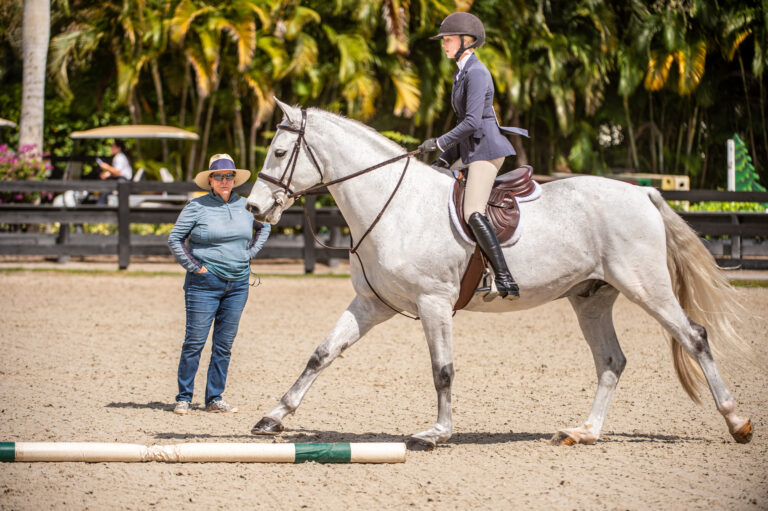
On this sunny October afternoon, I’m celebrating my 64th birthday with one last canter up a gentle slope. Four strides in, my 16.3-hand Dutch Warmblood gelding begins drifting left. I feel Bindigo’s back muscles bunch beneath the shallow, unpadded saddle I’d pulled off the tack-room wall. Hauling his more secure custom saddle from my house to the boarding stable had seemed too much trouble. But oh, to have my usual knee rolls to sink into! Oh, to have mastered the one-rein stop my husband is forever lecturing me about! I’m a sitting duck—but not for long.
Bindi launches an impressive crow hop. Glancing over his shoulder at the ground far below, I wonder, Am I going to fall? After 55 years in the saddle, I simply don’t do falling—and, with thinning bones, shouldn’t.
A second crow hop, followed by a duck, sends me cartwheeling. But luck is with me. The grass, softened by rain, cushions my landing. I practically leap to my feet, amazed to be unhurt. As I head off to catch my horse, I begin processing the lessons he’s reminded me of—from planning each ride to knowing when to quit.
Admittedly, earlier that day, Bindi had told me to quit—many times and in many ways. But I’d stubbornly persevered, demonstrating the my-way-or-the-highway school of riding.
Our outing began smoothly—despite my lack of planning. We trotted uphill and into the woods, sauntered downhill and resumed trotting on the flat. Then we doubled back at a hand-gallop, trot and walk. Soon we’d returned to the vicinity of the barn. A good time to end a birthday jaunt, eh? But nooooooo.
For the heck of it—not the best approach to training—I continued downhill past the barn. Before crossing a concrete bridge requiring horse and rider concentration, I answered my cellphone: my brother calling to wish me happy birthday. So much for safety-consciousness.
Once across the bridge, I sent Bindi straight into a trot in a grassy area. I hadn’t thought to look around first. But Bindi, a prey animal, had. Only after a 180-degree pirouette did I see what had spooked him: a man partially visible in the woods 30 yards away. Bindi’s airs above the ground spooked me. Here was my chance to regroup—to work him in the roundpen, re-establish our connection and switch our brains from reacting to thinking mode.
I wish I’d taken that opportunity. Instead, I urged Bindi past the barn again—anyone see a pattern here?—and up the gentle hill between pastures. I was still chasing the good note to end on. My horse became balky, surely thinking we were done. But he soon agreed to trot and canter on. Then everything headed south.
Our environment changed dramatically. Inexplicably, someone was riding in Bindi’s field, just to our right. Another rider was traversing a distant, usually empty pasture. My husband, 50 yards to our left, began videoing us. Complicating matters, I asked Bindi for a flying change—something that takes all his focus.
Suffering from sensory overload, Bindi uncorked—three times. I vowed that if he’d do a lead change in both directions in the arena, I’d call it a good day. To my chagrin, I broke that vow. Pleased with his changes, I wanted to celebrate with, yes, one last canter up the hill.
If I didn’t know better, I’d say trainer Julie Goodnight, a natural-horsemanship specialist, was on the sidelines. “Now he’s tired and emotionally spent and you ask for more,” she writes in her Feb. 8, 2017, blog, “A Horse’s Sense of Fairness.” “Things fall apart and what should have been a great training session turns into a salvage effort. Fairness would dictate that you recognized your horse’s best effort and let him rest on that rather than feed your own greed.”
Of course Bindi dumped me. I bought myself that fall. Luckily, the Bindigo Birthday Bonanza was a twofer, including a refresher course in good horsemanship. My takeaways? I must think out every step of my ride, focusing on clarity, consistency and compassion. No point is worth driving home if doing so is likely to land me in the ER. I need to ride my horse as he is today, not as I wish he were. And a good note to end on is no less good because it doesn’t take the form I originally envisioned.
This article was originally published in the October 2018 issue of Practical Horseman.










